An extraordinary piece of kit: Discovery unveils new look Cube with enhanced analytics capabilities for Tokyo Olympics
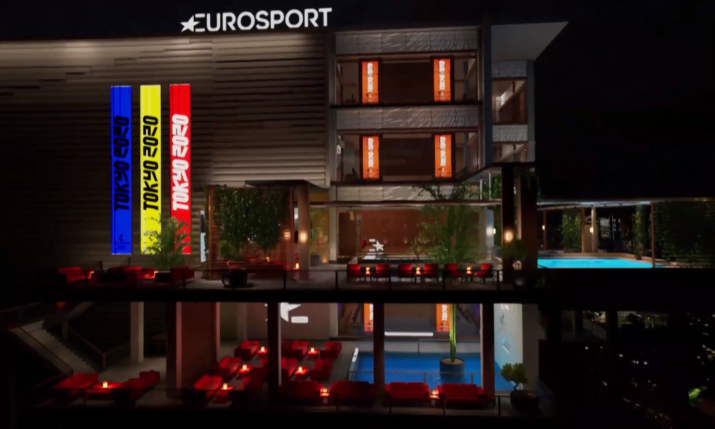
The Eurosport Cube for Tokyo 2020 is set over three floors with seven different ‘rooms’
Discovery has unveiled an enhanced three-storey, multiple ‘room’ Cube for the Tokyo Olympics that includes cutting edge analytical capabilities and a more gamified viewing experience for sports fans.
The new extended reality Cube studio will be the centrepiece of Discovery’s coverage of Tokyo 2020, showcasing new software and motion graphics that will push the Cube’s analytical capabilities to a whole new level, while giving viewers the chance to deep dive into the details of why an athlete won gold – or did not.
“We’re getting to boundaries now where are we going to need to find technology providers that can create and develop at the rate of which we can now think. Our production teams now across Europe are starting to realise the power of this Cube. It’s really only bounded by our creative thinking process”
The multi-location Cube studio for Tokyo 2020 features seven different immersive real-time video environment locations, or ‘rooms’, which will be used for different shows, bespoke 360-degree beauty shots of Tokyo as backdrops, newly-released 3D Zoom software to allow viewers to see wider panoramic views of Cube locations, and a virtual set extension with cameras able to roam around the digital environment, taking the gamification of this presentation studio to new heights.
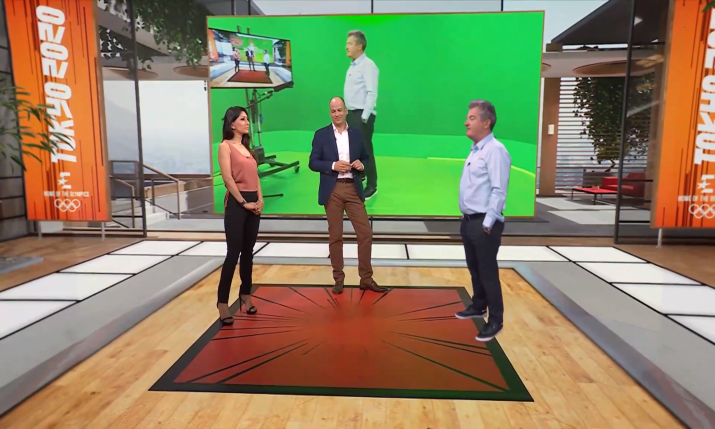
Discovery’s host presenter at the Cube, Reshmin Chowdhury, with Andrew Georgiou, president of sports at Discovery both in London, while Scott Young, Discovery’s senior vice president of content and production, speaks to the pair live from the Olympic IBC in Tokyo. On the virtual TV behind the group, Young shows what the studio he is speaking from looks like
Extraordinary piece of kit
On the new enhanced Cube, Scott Young, Discovery’s senior vice president of content and production, says from Tokyo: “Well, this is an extraordinary piece of kit. Virtual studios are not new in the world, but what Alex Dinnin [Discovery Sports’ head of graphics and innovation] and his team have created is extraordinary. It’s world-class.”
Adds Young: “This is virtual studios next level. It’s quite extraordinary.”
The Cube has been designed to create a virtual environment that will bring Japan to the viewer at home. This includes the atmosphere in the country as well, so if the weather is bad, the Cube will reflect that.
Explains Young: “We had a cracking thunderstorm here the other day that nearly tore the place apart, so how we react to weather in this environment is a key piece. You can see the trees and the plants behind you [and] we can start to make them sway in the background to get the environment going. If it’s getting a little stuffy [in Japan] we can open the doors, we can get a bit of breeze in there for you; a few more keystrokes and the Cube comes to life.”
Coverage within the Cube will follow the Japanese clock, creating night and day effects, and the presentation will move around the virtual three-storey building to different ‘rooms’ to suit each show style, from informal to formal.
Andrew Georgiou, president of sports at Discovery, comments on the night to day and multiple room aspects of the new Cube: “Certainly providing a different setting for the talent at different points in the day to create a different feel and a different outlook for the audience [is key]. I think if you’ve got two to three weeks of continuous coverage with the same setting it can get quite monotonous, I suspect, so [we’re] providing a different setting for everyone in order to be able to then [move] into a different place, a different setting. If we’re doing something relaxed you’ve got a soft area, if you’re doing an analysis it’s the formal area, with different times of day and different lighting. You’ve got different ways of creating a different atmosphere that I think makes it a little bit more authentic for the viewer to be able to experience the Games.”
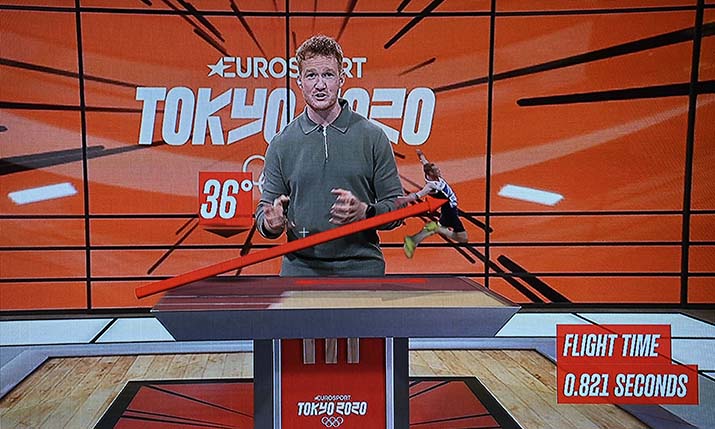
Discovery’s home of the Olympics in Europe, the new Cube, has launched with cutting edge analytics which will be ready for six or seven sports by the time the sporting event begins. Here, athlete and on-screen talent, Greg Rutherford, demonstrates some of the new capabilities
Expanded virtual environment
On why Discovery has chosen to expand on its virtual environment in the Cube far beyond what has been bought to screens up until now, Young says: “The art of the Cube is if you’re sitting at home watching our content, after a while you sort of forget that it’s not real. [This is] a broadcast for two weeks with an enormous number of sports and athletes and stories to tell and we want to keep the environment in which we’re telling that story as fresh as possible. So the reason that we’ve created a broader environment [within the Cube] is so we can have different locations to move around, and the reason we go from night to day is to be there and experience the environment as if we were here.
“That’s why we’re playing around with the wind [moving] the trees, and the doors [that] can open up,” continues Young. “You want it to be an interactive experience that when you’re sitting at home; it’s not just a passive set. And when you start to work with suppliers like Unreal Engine, you realise there is a lot that they can do. I think the gaming world is very adapt at understanding how you create a life-like as possible environment for people who spend a great deal of time in those environments.”
“The genius behind the Cube is actually sitting in the machine software at Stockley Park, which is taking the physical device that’s sitting on the floor and then the Unreal Engine platforms, the graphic platforms, that sit in behind it. It’s the complexity that’s back in our set up in London that makes it come to life”
As for the new analytical capabilities of the Cube, which are being developed using Unreal Engine, Discovery’s developers are still working to enable more sports to be put under the microscope within the Cube in Tokyo. By the time the Opening Ceremony takes place the company will have developed immersive explanations for six to seven specific sports.
Says young: “We’re working with developers very quickly to push the software as fast as we can get it to go across the new sports and emerging sports that are coming up. It’s a mixture between our creative ingenuity and the software developers and how we can start to understand how to bring those sports to life in the Cube. It’s not just an analysis tool like you would see in other sports where you’re talking about, you know, if you look at cricket for instance, and they show you where all the balls have been bowled; this needs to have a very different piece of software, a background so that we can bring that sport to life. So it takes time as the technology is developing as fast as our appetite is; supply and demand is probably our biggest challenge.”
This issue of supply and demand means Discovery is looking for technology partners that can keep up with and enhance its ambitious and creative ideas. Explains Young: “We’re getting to boundaries now where are we going to need to find technology providers that can create and develop at the rate of which we can now think. Our production teams now across Europe are starting to realise the power of this Cube. It’s really only bounded by our creative thinking process. So we now need to start with suppliers that are traditionally in that gaming world, and Unreal have been fantastic in a lot of the development [of the Cube]. Traditional television graphic platforms take quite some time to create that sort of development on, so we are going to need to look far and wide now to find partners that can actually keep up with our appetite.”
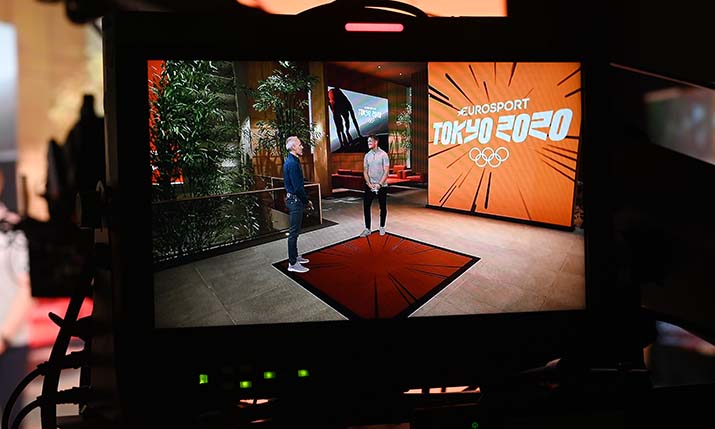 Genius behind the Cube
Genius behind the Cube
Discovery is working with NEP as its technical equipment provider on the ground and Globecast as its connectivity provider, with OBS’ Alibaba cloud as a backup path for its content. Young says: We operate with NEP who supply our technical equipment, and Globecast as part of our connectivity team here. Those two suppliers work very closely with us across our other sports productions and distribution [and] are well aware of what’s required for the Cube. So physically here [in Japan the Cube consists of] a room that has been painted green, with cameras and the monitors. The actual cube component at this end is actually quite simple. In fact, it’s a green screen studio that is still very native to its original green screen elements that were introduced many, many years ago.
“The genius behind the Cube is actually sitting in the machine software at Stockley Park, which is taking the physical device that’s sitting on the floor and then the Unreal Engine platforms, the graphic platforms, that sit in behind it,” continues Young. “It’s the complexity that’s back in our set up in London that makes it come to life.”
There is zero latency on the Cube, says Young, which uses uncompressed bandwidth. “It’s quite extraordinary,” he states. “I can tell you from walking in [to the Cube] and putting an earpiece in, you can have a conversation as if you were standing there [with the other person]. There is no latency like you would traditionally see if you would sending a news reporter out into the field on a mobile view kit. The conversation is real time, there’s no delay, you’re not waiting for anybody to throw to you.
“That’s done through very large pipes that we have here, but that’s part of the package of the 164 feeds that we’re sending back, and 44 of those are UHD feeds, which require an enormous amount of bandwidth. So the bandwidth package that we send back here and through the three different diverse paths give us the opportunity to send back full resolution for the full video from the Cube,” Young explains. “It’s not compressed in any way, which is where you would start to get into the necessity of latency.”
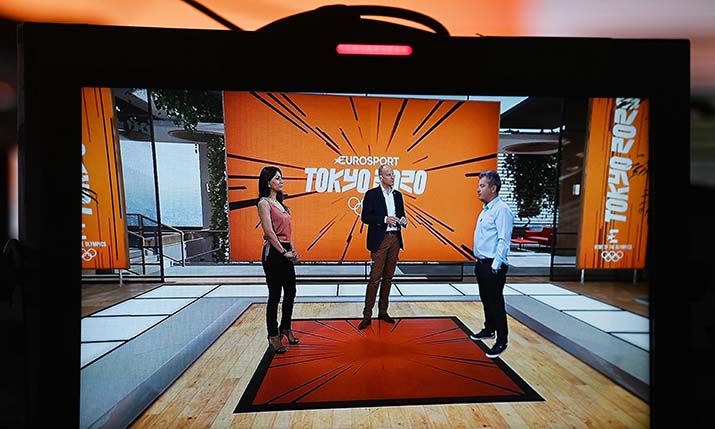
On-screen talent Reshmin Chowdhury speaks with senior Discovery executives Andrew Georgiou and Scott Young at the launch of the new look Cube
Proximity versus remote production
On the remote production aspects of the Cube, Young states: “Remote production is a really key part of international sports production these days now, where we’re absolutely focused on our content. We want our content to be as rich as possible. We want to be able to connect with those that are actually competing; it’s their story to tell, and we want to make sure that we’re as close to them as possible. So we need to have the technology where those athletes can be with us as quickly as possible. The Cube doesn’t replace our proximity; we still have teams here [in Japan] on the ground with our journalists, with live cameras at the mix zones, at the venues. What we don’t need to do is start to bring hundreds of people, to be able to interact with different markets across networks.”
Young adds: “Remote production was well in hand before the pandemic started. I think the pandemic has accelerated the ability for where remote production can really help, but I think it would be remiss to say that we’re doing all this because of COVID. I mean, remote production, it creates a far better opportunity for us to create more content and more sports across more platforms.”
The Cube’s host presenter for the Olympics, Reshmin Chowdhury, will be based at NEP’s facilities in Stockley park, London, throughout the Games. As a linguist, she will be able to interview athletes on the ground in Tokyo within in the Cube in multiple languages where appropriate, which will be sent as segments to other studio programmes in specific Discovery markets to be used for locally-focused content, “which in effect has saved us a great deal of effort really about just the uplift of sending people around the world,” notes Young.
He adds: “We’re an international sports broadcaster chasing global sport. So when you look at the complexity of what we do every day and the scale of what we do, it’s not really about one sport and one day; it’s about having the technology that allows us to be able to move across our sports, across our platforms, every day.”
Young comments on the future of Discovery’s remote productions: “We are in conversations with Olympic Broadcast Services (OBS) right now about our future Olympic events coming up, about how we can start to really look at further developing the concept of remote production and what remote production looks like in an OBS Olympic world. I think the two of us working together could create a very unique way of starting to cover and distribute the Olympic events.”
Interviews with athletes
Athletes are on a strict arrival and departure turnaround for the Games, landing a couple of days before they need to perform and flying out within 48 hours afterwards. Despite their tight schedules, Discovery and other broadcasters are able to bring them into the Cube at the IBC via a designated carpark, secure walkway and lift especially for athletes only to interview them.
Young refers to the Cube as a great way to maintain social distancing: “One of the great ways to ensure that you’re COVID safe is to ensure [that you’re] only person standing in a green screen studio talking to [someone else] on the other side of the world. I think our main asset [in this situation] is to make sure that we [have] the best storytellers that we can find, and we’ve gathered those people, and to remain distant from the athletes so they are safe, and to ensure that when we all leave that Japan remains in a safe state, and that’s been something that’s very much on the mind of the local media, but still be able to operate and attend the venues and access the sports that we want.”
For key interviews in Japan, athletes will be bought into Discovery’s green screen studio at the IBC in Japan where they will stand on their mark and see the person they are talking to on screens around them. Anyone can be bought into the virtual Cube world from anywhere using a large greenscreen, a broadcast quality camera, and good lighting, and that system can also be used to bring in people on a Zoom call. However for the full VR ‘teleportation’ aspect, a green screen studio is required.
Says Young: “And that’s what we’re rolling out across all of our key markets in Europe, which is why we can have Àlex Corretja when he’s in Madrid interviewing Rafael Nadal while he’s at Roland Garros, and neither of them are in the Cube, but when you’re at home watching it and they’re standing there talking to each other. That’s starting to push the boundaries of what people consider to be normal.”
Looking forward, Discovery is already focused on its production plans for Beijing 2022, where Young states it will have, “two significant locations for our production teams in Beijing because of the distance that we need to travel between multiple venues in Beijing”.
He adds: “The Cube is a really key part of that storytelling, to take people off the mountain, into the Cube and then back into Europe. And in fact this morning [14 June] we started with the team for Paris 2024, because we’re already into discussions; there’s only three years between Summer Games, so we’re on the countdown to that one already and the Cube again will be there.
“We’ll be at [Cube] 6.0 by then! It’ll be able to take off out of its environment and teleport itself somewhere by the time we get going! So we’re looking forward to what the Cube looks like in 2024.”

